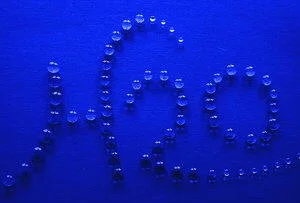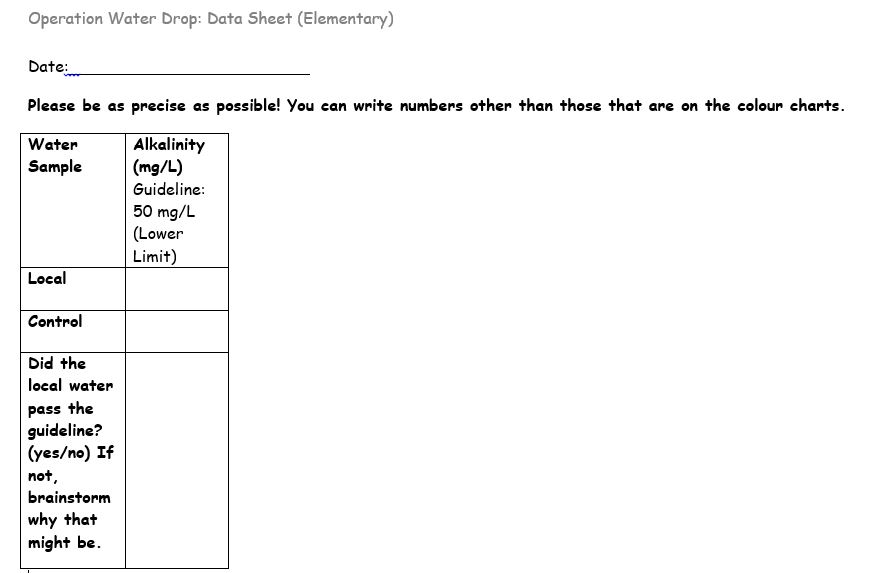Purpose: To determine how much alkalinity a sample contains using a colourimetric method. Testing will be done on a Local Community Treated Water sample; the teacher will do this as a demonstration.
There is no Canadian Drinking Water Guideline for Alkalinity in drinking water, but it is an important characteristic of the water and if your local community water is less than the Low Limit Sample (LLS) then the water may be quite corrosive, which may result in increased levels of copper and lead leached out from household plumbing.
Materials:
- 1 - 50 mL tube containing 50 mL of Alkalinity Low Limit Sample (LLS)
- 2 - 15 mL tube with 12.5 mL of 0.02N H2S04 (Sulphuric Acid)
- 1 - 1.5mL tube with Methyl Purple Indicator
- 1 - Small 1.2 mL plastic pipette
- 2 - Plastic cups
- 50 mL graduated cylinder (not supplied with kit – teacher must supply)
- scrap paper
- rubber gloves
Method:
Cover the area that you are working on with paper and use gloves as the Methyl Purple Indicator that you will be using may stain.
Label the 2 plastic cups as follows; label one cup Alkalinity LLS and the other cup Local Community Treated Water.
Pour the 50 mL of Alkalinity LLS into the cup labeled Alkalinity LLS.
Add 7 drops of Methyl Purple Indicator to the cup by using the small plastic pipette. This causes the water to turn green. Be careful when using the Methyl Purple Indicator as it may stain.
While swirling the water in the cup, add the 0.02 N H2SO4 slowly until the water turns purple, the LLS should take around 2.5 mL, record your reading (the volume you used is initial - the next reading, say 12.5 – 10.0 = 2.5) after you see the colour change. The other samples may take more or less than the LLS. Record amount of H2SO4 used. Then add the remaining Sulphuric acid to see the colour changes (there should be a slightly darker colour after you add all of the acid).
Using the graduated cylinder, measure 50 mL of the Local Community Treated Water sample and pour it into the cup labeled Local Community Treated Water sample.
Repeat steps 4 & 5.
Calculate the amount of alkalinity in the different water sources. You can do that by knowing that the LLS is 50 mg/L and it required around 2.5 mL of acid.
Write your results:
Results:
If the water sample requires less than 2.5 mL of 0.02 N H2S04 to change colour then the water may be quite corrosive (read more about alkalinity below). You can multiply the amount of acid added by 20 and change the units to ppm in order to get the result in parts per million. For example, if 2.5 mL of acid is added then 2.5 x 20 = 50 ppm.
Safe Handling of Materials
Caution must be taken at all times when handling any chemicals. Although this test is safe to use in any area, please be cautious with the materials supplied.
Visit the Safe Drinking Water Foundation Website www.safewater.org
Alkalinity:
What is alkalinity and why do we test our water for it?
Alkalinity is a measure of the ability of your water to resist changes in pH, which would tend to make the water more acidic. The pH is a value given to indicate how acidic or how basic a substance is. It is important that there is a good balance to the alkalinity of our water. In Canada, the recommended range of alkalinity is 80- 120 ppm or parts per million. If the levels are higher or lower than this, there can be problems with water quality. However, alkalinity levels are usually looked at together with pH levels to get a better idea of the complete water quality.
Where does alkalinity in water come from?
Alkalinity of water is due to the presence of certain ions: carbonates, bicarbonates, and hydroxides (often referred to as alkaline salts). Bicarbonates are the most common cause of alkalinity and are found in almost all natural water sources, as are carbonates. Hydroxides are found less often in natural water but concentrations may increase after certain treatments.
What happens if alkalinity is too low or too high?
If the alkalinity is too low, the ability of your water to resist pH changes decreases. This means that the pH will yo-yo up and down, changing from acidic to basic fairly rapidly. Water with low alkalinity can also be corrosive which can result in copper and lead leaching out of household plumbing. It can also irritate the eyes. Water with high alkalinity has a soda-like taste, can dry out skin and can cause scaling on fixtures and throughout water distribution systems. This scaling is undesirable because it begins to decrease the efficiency of plumbing systems, which results in greater power consumption and increased costs. There do not appear to be serious adverse health effects from drinking water with alkalinity above or below the suggested levels. However, many public water utilities try to maintain an acceptable alkalinity level in order to prevent low pH (acidic) water from damaging pipelines and other distribution equipment.
Metal water pipes can become corroded due to water with low Alkalinity and pH.
What do I do if the level of alkalinity in my water is too low or too high?
Some simple household compounds can bring the alkalinity within the suggested range. In order to increase the alkalinity, baking soda (Sodium bicarbonate) can be used. To decrease the alkalinity, muriatic acid (Hydrochloric acid) can be added. We don’t recommend that you do this as alkalinity problems should be dealt with in a water treatment plant.




